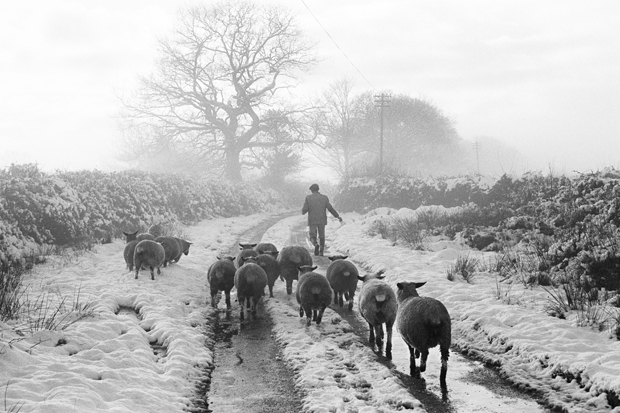So, what are you doing with your Christmas decorations? Still up? Did the tree get put out on 2 January? Maybe you’re holding out until the Twelfth Day, on the basis that it’s bad luck to have the decorations up after that? Or are you going out on a limb and keeping your holly, bay and ivy up until 2 February, Candlemas? This last is in fact the correct answer for traditionalists; prior to Victorian times, people kept the Christmas season going, along with the greenery, right up until Candlemas. Mind you, given that Christmas trees only caught on with Prince Albert, pre-Victorians didn’t have the problem of pine needles dripping all over the carpet.
The gap between the Christmas season as now celebrated, and how it once was, sums up something of the gist of Nick Groom’s beguiling book, The Seasons. For, as he points out, if Christmas now ends long before the Twelve Days that the sixth-century Council of Tours prescribed for the celebrations, it also starts long before Christmas Eve, which used to be the beginning of the party season — preceded by Advent, a time of fasting. ‘The season of Christmastide has, in other words,’ he observes, ‘shifted forward, as if it now expresses an impatient and premature desire for gratification. The result is that there are two cold months of winter following Christmas.’
This inversion of the Christmas season is just one of the ways this book documents in which contemporary Brits — or rather, English — have distorted or discarded the traditional course of the seasons, which once gave shape to people’s lives. There were two aspects to the cycle of the pre-industrial — actually, the pre-20th century — year, as described here. One was the rhythm of agricultural work, which imposed its character on each season; the other, closely bound up with it, was the round of the Church’s year — the saints’ days, fasting and feasts. These gave a natural shape to the annual round of work and play: one was undermined by industrialisation and before that by the enclosure of common land; the other by the Reformation and, later, secularism.
There is, indeed, an elegiac quality to this book. It summons up the ghosts of a vanished world, though, as the author points out, some aspects of that world show
unexpected signs of vitality, and he himself does his bit to keep it going by playing the part of St George in his village’s annual festival ‘in chain mail weighing some 40 pounds in a traditional pace-egging play’, and urges the reader to similar efforts. Indeed the captivating black-and-white photographs throughout the text — check out the wondrous Victorian sideburns on one agricultural labourer in 1977 — are oddly recent, from the Seventies and Eighties.
The book takes us through the seasons, but with discursive chapters about things like the calendar. It’s unexpectedly fascinating: England held out against adopting the popish Gregorian calendar until 1751 when the Earl of Chesterfield persuaded Parliament to adopt change. He told his son: ‘I could just as soon have talked Celtic or Sclavonian to them as astronomy’, so he gave them an amusing series of anecdotes instead, which did the trick. Interestingly, nature stuck to the Julian calendar: the holy thorn at Glastonbury insisted on flowering on the old Christmas Day; similarly the oxen which by tradition bent the knee in the stable at Christmas midnight kept to the old date.
Groom is not the first to point out the effects of the Reformation, industrialisation and the Victorian cult of the family on communal celebrations: the historian Ronald Hutton has documented all this comprehensively and Eamon Duffy did so in respect of the Reformation. But what Groom brings to the party — even if it is a wake — is a lively compendium of literary references to illumine (he’s an English Lit academic) and a crusading zeal to revive the old traditions. His book is
a hybrid study, a sort of antiquarianism for the present times: part history, part almanac and part polemic — both a restitution of waning lore and a rallying cry for national renewal.
His quest for contemporary versions of old customs can be dispiriting. He seeks out the Priddy Fair in the Mendips, only to find it a noisy funfair, with the livestock elements pushed to the margins. Our equivalents, the Notting Hill carnival or rock festivals, were, he points out, dwarfed by the riotousness of the St Bartholemew Fair in Smithfield, 1133–1855.
One aspect of his argument doesn’t quite wash: that these traditions were essentially rural rather than universal. One of the most moving descriptions of the pre-Reformation Christmas (and midsummer) was by John Stow in his Survey of London. Feast days were kept in towns as well as villages and, prior to the Reformation, by rich as well as poor. Pepys’s diary is proof that London kept the annual cycle of festivities as well as country folk. (One tradition Pepys upheld was to take Christmas cake on Twelfth Night containing tokens for divination; he slipped the clove from his slice — symbol of a knave — onto someone else’s plate.)
Nonetheless, the point is well made, that many customs were grounded in the agricultural cycle, which was in turn underpinned by the church’s calendar. In fact, given the centrality of the cycle of the Christian year to the traditions he describes, it seems odd that churchgoing doesn’t feature among the customs he wants to preserve.
The book has an engagingly frank agenda. (Just so you know, he takes climate change seriously and doesn’t sound terribly keen on hunting.) He’s nationalist, in a benign way: he wants to preserve the culture of the English countryside as part of the national ecosystem. And his manifesto isn’t so very taxing. Go along to a cheese-rolling festival or village bonfire, he urges, and do your bit by propping up the bar. ‘They also serve who only stand a round.’ I think he’s onto something.







Comments